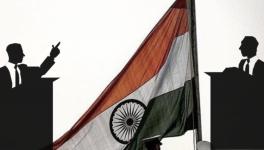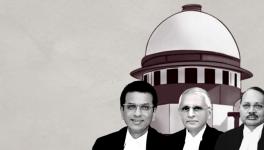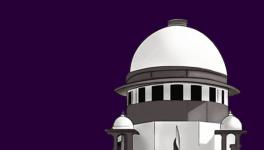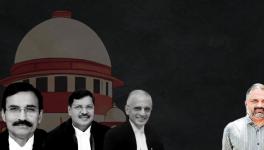Life and Liberty: India at 75 years of Independence
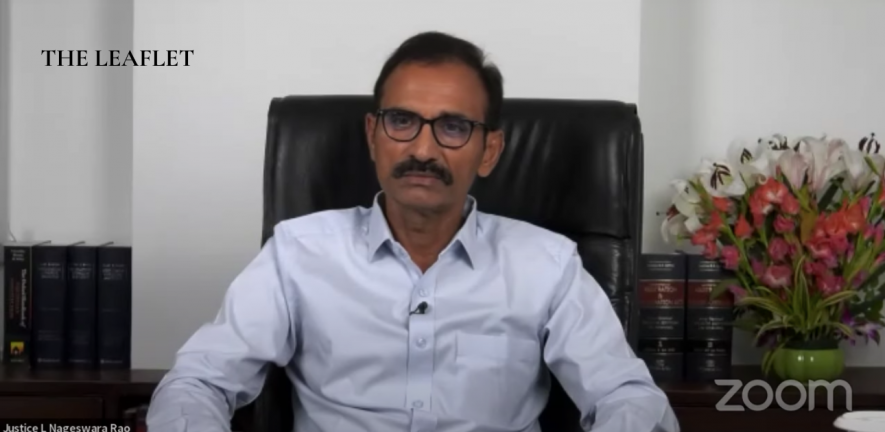
On this momentous milestone, I am very pleased to be amongst you all. I take this opportunity to engage in some introspection into the idea of India and our identity as a democratic society after 75 years of our independence. As you would note, the evolution of our understanding of ‘liberty’ is the chosen marker for today’s discussion.
In the words of Aristotle, “the basis of a democratic state is liberty”. But what does liberty mean? When we list liberty as the bedrock of a democratic nation, what is it that we seek to preserve or achieve? Surely, we cannot frame the sum and substance of liberty as a goal nor contextualise its significance in the exact notions as may have been done through time, say by the Founding Fathers of America or by the average Indian citizen under the British rule or by a person on the death row today.
Possibly, the first instrument which bears a reference to ‘liberty’ is the Magna Carta issued in 1215, which was intended to be a peace treaty to end a civil war between King John and rebellious barons. Although rooted in war and thereafter, repudiated and re-issued several times, the Magna Carta has shaped the development of the law in England, the United States and several parts of the globe. Also referred to as a Charter of Liberties, it promised to the entire political nation autonomous conduct, restraints on executive power and the rule of law. The most widely commemorated provision of the Magna Carta is that: “No free man shall be seized or imprisoned, or stripped of his rights or possessions, or outlawed or exiled, or deprived of his standing in any way, nor will we proceed with force against him, or send others to do so, except by the lawful judgment of his equals or by the law of the land”.

Thus, the Magna Carta was instrumental in entrenching the due process of law, which was subsequently developed by means of judicial decisions and legislations. In the celebrated decision in Semayne v. Gresham rendered by the King’s Bench, the right of a home-owner to defend their premises against intrusion to those seeking to enter under lawful authority was deliberated upon. Sir Edward Coke, while laying down that there were strict limits on how Sheriffs may enter a person’s house to issue writs, stated: “That the house of every one is to him as his Castle and Fortress as well for defence against injury and violence, as for his repose”. Since quoted as a well-known maxim ‘A man’s home is his castle’, this has influenced the discourse on liberty across jurisdictions, including India.
As is known, the Constitution of England does not contain a code of fundamental rights. Through the concept of due process and the writ of Habeas Corpus, a balance has been struck between public security and individual liberty. However, as individual rights are sourced from ordinary legislations of the land, under the prevailing doctrine of parliamentary supremacy, the Parliament may limit individual rights to give way to greater public good at any time, at least hypothetically. While it falls on the Judiciary to safeguard individual rights, such powers of review exist against the executive only and do not extend to legislative acts.
In contrast, the Constitution of the United States codifies guarantees to individual rights. While the original constitution adopted in 1789 did not provide for a charter of individual rights, the first ten amendments to the constitution contain a list of rights which were guaranteed also against legislative measures.
John Locke, considered the guiding spirit for America’s founding fathers, believed that while individuals were subject to natural law, they also had natural rights, i.e., the right to life, liberty and property. Unlike Hobbes’ social contract, where men surrendered their freedom to the sovereign, according to Locke, men had merely entrusted power to a ruler in return for justice and mutual security on the condition that their natural rights are protected, as these rights were derived from something higher than the edicts of princes and were therefore, inalienable.
The framers of the American Constitution, who were apprehensive of not only the high-handedness of the executive but also of encroachment by the legislature, secured personal liberty through the 5th and the 14th Amendments. A part of the 14th Amendment is that: “No state shall make or enforce any law which shall abridge the privileges or immunities of citizens of the United States; nor shall any state deprive any person of life, liberty, or property, without due process of law; nor deny to any person within its jurisdiction the equal protection of the laws.” While attempting to balance public security and individual liberty, the Due Process clause serves to ensure that for the exercise of police power by a state to be considered lawful in maintenance of public peace and order, such exercise limiting individual rights cannot be arbitrary, unrestrained by the principles of distributive justice.
The provision of fundamental rights in our Constitution is drawn, not from the principle of natural justice inherent in British Common Law but on the American principles of constitutional guarantee. Part III of the Constitution guarantees justiciable Fundamental Rights to citizens of India, and in some cases, to all persons, whether citizens or foreigners, the enforcement of which can be sought before constitutional courts under writ jurisdiction. Article 14 extends to each person two aspects of equality: first, being equality before law, which is the negative content of the right wherein no one is above law and every person whatever his rank or condition is, is subject to the ordinary jurisdiction of courts. This aspect is antithetical to discrimination in any form. The second aspect, that is equal protection of laws, is viewed as the positive content of the right. This entails application of laws alike and without discrimination to all persons similarly situated and is the codification of the principle of substantive equality in our Constitution.
Article 19 charts out the freedoms secured to citizens, which are not absolute in nature. In its present form, Article 19 guarantees the right to (1) freedom of speech and expression, (2) assemble peaceably and without arms, (3) form associations or unions or co-operative societies, (4) move freely throughout the territory of India, (5) reside and settle in any part of the territory of India, and (6) practise any profession, or carry on any occupation, trade or business. However, the exercise of these freedoms is restricted by way of Clauses (2) to (6) of Article 19, which impose limitations in the interests of the sovereignty and integrity of India, public order, morality and other such enumerated competing factors. However, our Constitution has gone a step further than the American Constitution by defining the scope of the limitations on the civil liberties under Article 19 – the restrictions imposed are to be ‘reasonable’. Of course, without a fixed standard of reasonableness provided in the Constitution itself, it was left to the Judiciary to grapple with setting out the contours of the standard that should be applied in assessing whether the impingement of liberty protected under Article 19 has a ‘reasonable’ relation to the authorised purpose.
Article 21 of the Constitution of India mandates that no person shall be deprived of his life or personal liberty except according to procedure established by law. As is common knowledge, the American Due Process Clause was the inspiration behind the Constituent Assembly’s construction of Article 21. Dr Ambedkar’s draft constitution contained a due process clause which was identical to the 14th Amendment of the US Constitution. However, in a meeting between Justice Felix Frankfurter of the US Supreme Court and Sir Benegal Narsing Rau, constitutional advisor in 1947, the latter was advised to delete the phrase ‘due process of law’ from the draft constitution. This was induced by the ‘Lochner era’ of the US Supreme Court, which prevailed at the time of drafting of the Constitution of India. In Lochner v. New York, the US Supreme Court had invalidated a New York statute which imposed a bar on employees in bakeries working for more than 60 hours per week or ten hours a day, as the Court was of the opinion that the restriction in the statute impeded with a person’s liberty to contract!
‘Due process of law’ was replaced by ‘procedure established by law’ in our draft constitution – however, this was a highly contentious and intensely debated amendment. Several amendments were moved by the members of the Constituent Assembly to re-introduce the phrase ‘due process of law’. The apprehension in having the phrase deleted was put into words by Kazi Syed Karimuddin in that it did not permit the courts to look into ‘the injustice of a law or into a capricious provision of law’. He said, ‘As soon as the procedure is complied with, there will be an end to everything and the judges will be only spectators’. However, ‘procedure’ established by law became permanently etched in our Constitution with all amendments to alter it having failed.
To compensate for the removal of ‘due process’ which could prove to be inimical to individual liberty, a new provision, draft Article 15A was inserted, which went on to become Article 22. This was intended to instil safeguards comparable to due process, such as, those arrested and detained had a right to be informed of the grounds of their arrest, to consult and be defended by a lawyer of their choice and to be produced before a magistrate within twenty-four hours of the arrest.
Dr. Ambedkar was of the belief that while clauses (1) and (2) of Article 22 were already found in the CrPC, by incorporating them into the Constitution and shielding them from abrogation by the Parliament and the State Legislatures, a fundamental change had been brought about to protect against illegal or arbitrary arrests. However, Article 22 further goes on to create an exception to the ordinary rules of criminal due process and permits preventive detention up to three months, that is, without trial, and also permits the Parliament to decide the maximum time for which a person can be thus detained.
This draft Article was also a provision of fierce debate amongst the members of the Constituent Assembly. Many expressed concerns around the period of 3 months being too excessive and fell back on their own experiences of incarceration under the British rule to highlight the issues of a legal order permitting deprivation of liberty without fair process.
Mahavir Tyagi was most adamant in his expression of concerns around the subject when he said that : “This is a charter of freedom that we are considering. But is this a proper place for providing for the curtailment of that very freedom and liberty? When freedom is being guaranteed, why does the Drafting Committee think it fit to introduce provisions for detaining people and curbing the freedom? This is an article which will enable the future Government to detain people and deprive them of their liberty rather than guarantee it.”
Dr. Ambedkar defended the inclusion of preventive detention by considering it necessary “in the present circumstances of the country”. In such cases, he did not think that “the exigency of the liberty of the individual should be placed above the interests of the State”. Scholars have pointed out that the circumstances referred to by Ambedkar were those of Partition. In the context of the enormous bloodshed, the extensive displacement that people were facing and the imminence of communal violence breaking out, these provisions were considered necessary to protect public order.
Unsurprisingly, the first landmark decision where the Supreme Court was called upon to interpret the meaning of ‘life and liberty’ under Article 21 dealt with the constitutional validity of the Preventive Detention Act, 1950. In A.K. Gopalan v. State of Madras, the Petitioner argued that the Preventive Detention Act, 1950 not only contravened Article 21 but was also violative of Articles 13 and 19. Further, it was contended that under Article 21, procedural due process of law was guaranteed to every person in India and ‘procedure established by law’ should be construed as due process of law to give true meaning to the provision.
The plural opinion of the Supreme Court was that Articles 19 and 21 occupy exclusive domains and reading freedoms as overlapping between Articles 19 and 21 would require the alleged infringement to be tested against Article 19 as well, which imposed additional restrictions on the State. Only Fazl Ali, J. was of the view that Part III did not contemplate that each article is a code by itself and is independent of the others. According to him, preventive detention which was dealt with in Article 22, amounted to deprivation of personal liberty referred to in Article 21 and was a violation of the right of freedom of movement dealt with in Article 19(1)(d).
Again, the contention of the Petitioner that the words “procedure established by law” denoted the “due process of law” was not accepted by the majority, who were heavily influenced by the Constituent Assembly Debates and the deliberate act of the framers of our Constitution in avoiding “due process of law”. Therefore, once a procedure was established by law, meaning once a law was validly enacted by the Legislature, Article 21 could not have been infringed.
This interpretation of Article 21 gave way in the landmark judgment of Maneka Gandhi v. Union of India. The petitioner’s passport had been impounded under the provisions of the Passports Act, 1967 and the Government had decided “in the interest of general public” not to furnish her a copy of the statement of reasons for having passed such order. The Petitioner contended that the relevant provision of the Passports Act was violative of Article 14, Article 21 as the procedure prescribed under it was wholly arbitrary and unreasonable. The Supreme Court, in deciding this case, made it explicit that there existed freedoms which were covered by both Articles 19 and 21 and for such freedoms, the State would have to satisfy the requirements of both provisions, along with meeting the non-arbitrariness standard sourced in Article 14.
The thrust of this case, however, was on the interpretation of the words “procedure established by law”, wherein a majority of the judges came to the conclusion that a procedural law which deprived ‘personal liberty’ had to be ‘fair, just and reasonable, not fanciful, oppressive or arbitrary’ – thereby, reading the right to be heard before having one’s passport impounded under the Passports Act. This pronouncement turned Gopalan’s finding on absence of procedural due process in our Constitution entirely on its head and cemented a marked revolution in the ‘due process’ jurisprudence under Indian constitutional law.
Even before Maneka Gandhi, attempts had been made to explore rights that could be covered within the meaning of ‘personal liberty’. Article 21 evolved over the decades to encompass the right to live with dignity, the right to privacy, right to fair trial, access to justice, the right to adequate nutrition, clothing, shelter and facilities and several other socio-economic rights. However, I will be limiting this talk to the relevance of physical liberty and the protections afforded to it, as they stand today.
“Bail is the rule, jail is an exception.” Despite this phrase having been repeated by courts ad nauseum, it is an undeniable reality that jails in India are overflowing with undertrial prisoners. In a recent judgment of the Supreme Court in Satender Kumar Antil v. CBI, issuing directions to investigating agencies as well as courts for non-compliance with Sections 41 and 41A of the CrPC and directions given in earlier judgments, the Court notes that majority of the undertrials are not even required to be arrested despite registration of a cognisable offence, being punishable for seven years or less – which unfortunately puts on “exhibit the mindset of investigating agencies, a vestige of colonial India, notwithstanding the fact that arrest is a draconian measure resulting in curtailment of liberty and is thus to be used sparingly”.
The State’s proclivity to act first and make out a case subsequently has increasingly resulted in filing of FIRs and initiation of criminal process, without investigating agencies applying their minds, at times, to even assess whether the alleged act meets the minimum ingredients of an offence under the IPC or other substantive penal acts. Another prominent strategy employed is to selectively prosecute opponents and dissenters, in a bid to muzzle or discredit critical or contrary voices. A database, launched by Article14, a research and reportage initiative, followed 13,000 cases of sedition between 2010-2021 and indicated that out of 126 people for whom trials had been concluded in this period, 13 were convicted of charges of sedition, which accounts for 0.1% of those who faced such charges.
It is not uncommon to see the invocation of harsh legislations, including anti-terror laws, towards instances which are not strictly within the confines of the offences they seek to penalise. The criminal justice system today can be perceived as one prioritising expansion of State power in the name of public order by limiting individual liberty. A trigger-happy approach towards initiating criminal prosecution can amount to the criminal process itself constituting punishment or retribution, a tactic to threaten or censor those who the State might perceive as presenting a challenge to its authority or legitimacy.
In the face of the apparent bleakness of the situation, it must be remembered that the Supreme Court has been known to intervene through the decades to preserve the core constitutional ideas and act as the bulwark of liberty against attempted encroachments. Looking as far back as the Preventive Detention Act, 1950, the Supreme Court had, through a spate of judgements, given extensive relief to detenus by applying procedural safeguards provided in Article 22.
In Puranlal Lakhanpal v. Union of India, the Court, tasked with interpreting Article 22(5) of the Indian Constitution, concluded that an opinion of the Advisory Board indicating that there was sufficient cause for detention would be required to per se continue with the detention of an individual under preventive detention laws and not only to extend the period of detention beyond the prescribed period of three months. The Courts have questioned detentions where the Advisory Board submitted its report too late or the detaining authority acted mala fide and set aside detention orders if the grounds were found to be vague or irrelevant.
With time, the Courts used dignity to broaden the scope of the right to life, especially in cases pertaining to prisoners and their treatment while incarcerated. It is acknowledged that the Supreme Court may have dealt a grave blow to its legitimacy when it failed to prevent arbitrary arrests and detentions during the Emergency of the mid-1970s in the ADM Jabalpur case. However, the Court has always come back, more conscious and with renewed affirmation to its constitutional duty, as can be seen from judgments dotting its relatively short yet noteworthy history.
In Sunil Batra v. Delhi Administration, the Supreme Court, while addressing questions on constitutionality of solitary confinement and bar fetters, ruled that “Fundamental rights do not flee the person as he enters the prison although they may suffer shrinkage necessitated by incarceration. Where the rights of a prisoner, either under the Constitution or under other law, are violated, the writ power of the court can and should run to his rescue. There is a warrant for this vigil.”
Continuing to be the torch-bearer of ‘dignity’, the Supreme Court went on to decry the practice of hand-cuffing in the case of Prem Shankar Shukla v. Delhi Administration as “prima facie inhuman and therefore, unreasonable, over harsh and at the first blush, arbitrary”.
It further declared that “absent fair procedure and objective monitoring to inflict “irons” is to resort to zoological strategies repugnant to Article 21”. While engaging with the rights of detainees, the Court has made significant pronouncements on custodial torture and death, sexual violence in custody and issued wide-ranging directions on procedure for arrest, treatment of inmates, living conditions and access to legal aid.
The Court has not limited itself to elaborating on rights of those whose liberty has already been checked. The Supreme Court has been persistent and intrepid in confronting the misuse of criminal process by the State and has denounced such practices in a number of judgments.
Elaborating on the role of courts in protecting human liberty, the Supreme Court in Arnab Manoranjan Goswami v. State of Maharashtra was unambiguous in urging courts to be alive to the misuse of criminal law. The Court held that “it is the duty of courts across the spectrum… to ensure that the criminal law does not become a weapon for selective harassment of citizens. Courts should be alive to both ends of the spectrum – the need to ensure the proper enforcement of criminal law and the need, on the other, of ensuring that the law does not become a ruse for targeted harassment. Liberty across human eras is as tenuous as tenuous can be.”
In the recent judgment of the Supreme Court granting interim bail to the journalist Mohammed Zubair in FIRs registered for a series of tweets made by him on the social media platform, having found that the Petitioner had been subjected to a sustained investigation by the Delhi police, the Court saw no reason or justification for the deprivation of the liberty of the petitioner to persist any further. The Court sought to paint a very significant demarcation of the existence of the power of arrest from the exercise of the power. Recognising that the petitioner was trapped in a vicious cycle of the criminal process where the process itself had become punishment, the Court reiterated the guidelines laid down in Arnesh Kumar v. State of Bihar with respect to power of the police to arrest individuals, emphasising that such power was not unbridled.
It is also of note to consider the role of the courts in seeking to develop the liberty jurisprudence within the parameters of special acts, such as the Unlawful Activities (Prevention) Act, 1967. The 2008 amendment to the UAPA required the Court to deny bail if there were reasonable grounds to believe that the case against the accused was prima facie true. This made it difficult to secure the grant of bail as the Court was required to form its opinion only from the chargesheet prepared by the National Investigating Agency (NIA), beyond which the accused can provide no evidence. Despite the provision, the Supreme Court has granted bail to the accused who have undergone long periods of incarceration, seeking to balance the alleged offence against how long the accused had suffered and how likely a swift trial was.
In Union of India versus K.A.Najeeb, the Court was of the view that statutory restrictions such as S. 43-D(5) of the UAPA did not oust the ability of constitutional courts to grant bail on grounds of violation of Part III, with the rigours of such provisions melting down when there was no likelihood of trial being completed within a reasonable time and period of incarceration had exceeded a substantial part of the prescribed sentence. Keeping these parameters in mind, the Court has continued to enlarge individuals charged under the UAPA, with Varavara Rao in the Bhima Koregaon case being the latest beneficiary, where the Court also took into consideration his medical condition.
These judgments are by no means lone instances of the Court acting as the guardian of the inestimable right to liberty. Rather, they are beacons of hope as to the way forward. The framers of our Constitution had believed in the Constitution to remain relevant and influential as long as the three arms of the State continued their allegiance to the roles carved out for them under the Constitution. With any one arm exceeding the boundaries of constitutional exercise of its power, the fragile equilibrium goes askew. Irrespective of who such imbalance may seek to favour in the immediate future, if we turned away from the gradual erosion of constitutionally-protected values, it is ‘We, the People of India’, who stand to lose our somewhat imperfect yet precious democracy – a heavy cost that will be borne by all and sundry.
Another significant suggestion that had come forth from Justice Frankfurter to Shri Benegal Rau at the time of preparation of our draft constitution was to have the Supreme Court of India sit en banc. However, due to practical considerations such as the number of the judges in our Supreme Court, and the volume of cases that are before the Court, we have not taken the same approach as that of the US Supreme Court. The task of a judge is not easy – it is indeed difficult to interpret and apply the ‘law’, without viewing values and principles through the lens of one’s personal belief systems, at times.
Benjamin Cardozo, a celebrated American jurist and judge of the US Supreme Court, deliberates on the forces which judges avowedly avail to shape the form and content of their judgments in his book ‘The Nature of the Judicial Process’. He says, “Even these forces are seldom fully in consciousness. They lie so near the surface, however, that their existence and influence are not likely to be disclaimed. … Deep below consciousness are other forces, the likes and the dislikes, the predilections and the prejudices, the complex of instincts and emotions and habits and convictions, which make the man, whether he be litigant or judge.”
It is natural, therefore, for there to be some variance at times in the application of law by the Court. However, such departures cannot, and should not, create a dent in the vast and rich jurisprudence developed systematically and painstakingly by the Supreme Court, speaking through scores of judges, to act as a true combatant against the infraction of fundamental rights, on behalf of all those who lay claim.
Late last year, the Supreme Court has issued notice to the Central Government in a writ petition challenging the constitutional validity of the UAPA. Earlier this year, while considering petitions challenging S. 124A of the IPC, the Supreme Court, after noting the stand of the Government that the colonial provision required reconsideration as it was out of tune with the current social milieu, ordered for the provision to be kept in abeyance till the Union Government reconsidered the provision. It also held that those who were already booked under S. 124A and under incarceration could approach the concerned courts for bail.
It is the very same court, which has, in recent years, adopted the concept of ‘transformative constitutionalism’ to re-imagine and re-interpret constitutional provisions which, though drafted over 70 years back, comprise an instrument enabling the India of today, and of the years to come, to secure and give full expression to the ideals of liberty, equality and fraternity. The Court, as the custodian and interpreter of the Constitution, has taken note of the purpose of having a constitution, which is to transform a constantly changing factual and social reality for the better. It is to this bounden duty that the courts must continue to swear fealty.
Get the latest reports & analysis with people's perspective on Protests, movements & deep analytical videos, discussions of the current affairs in your Telegram app. Subscribe to NewsClick's Telegram channel & get Real-Time updates on stories, as they get published on our website.










